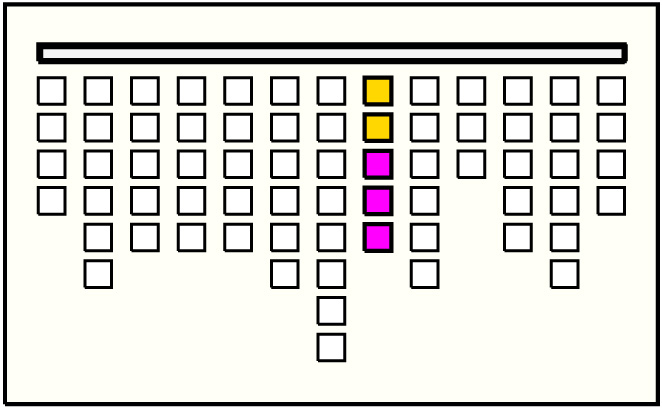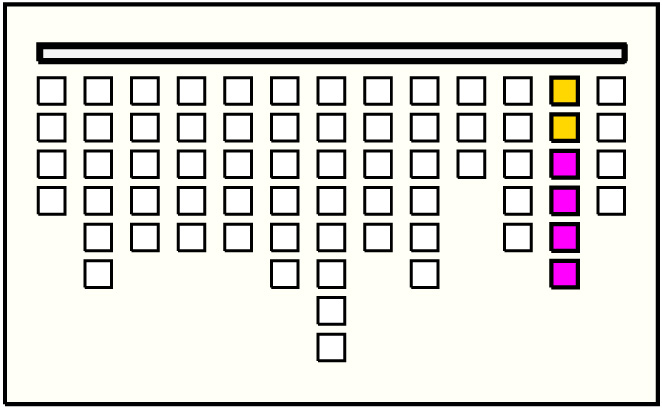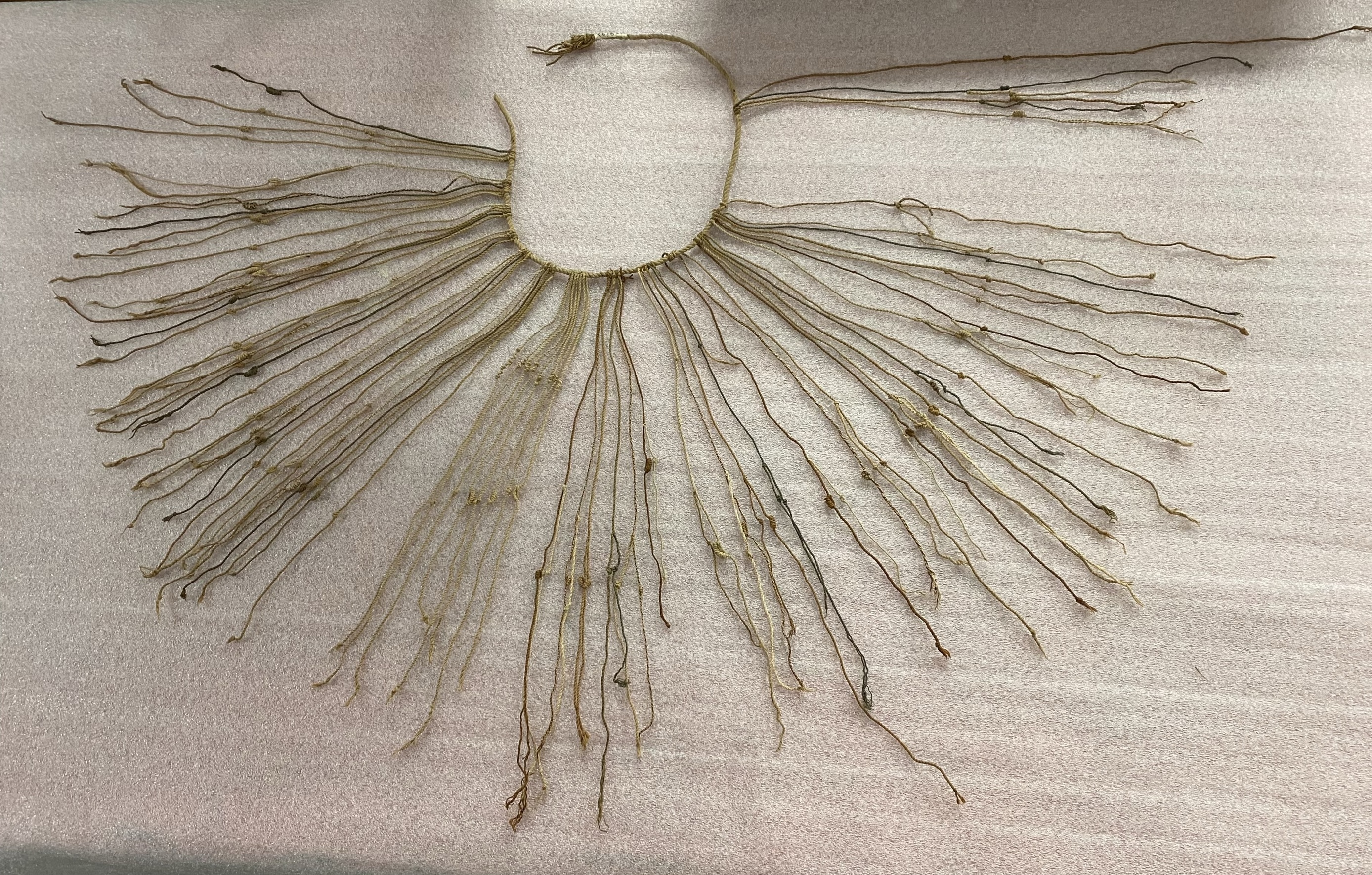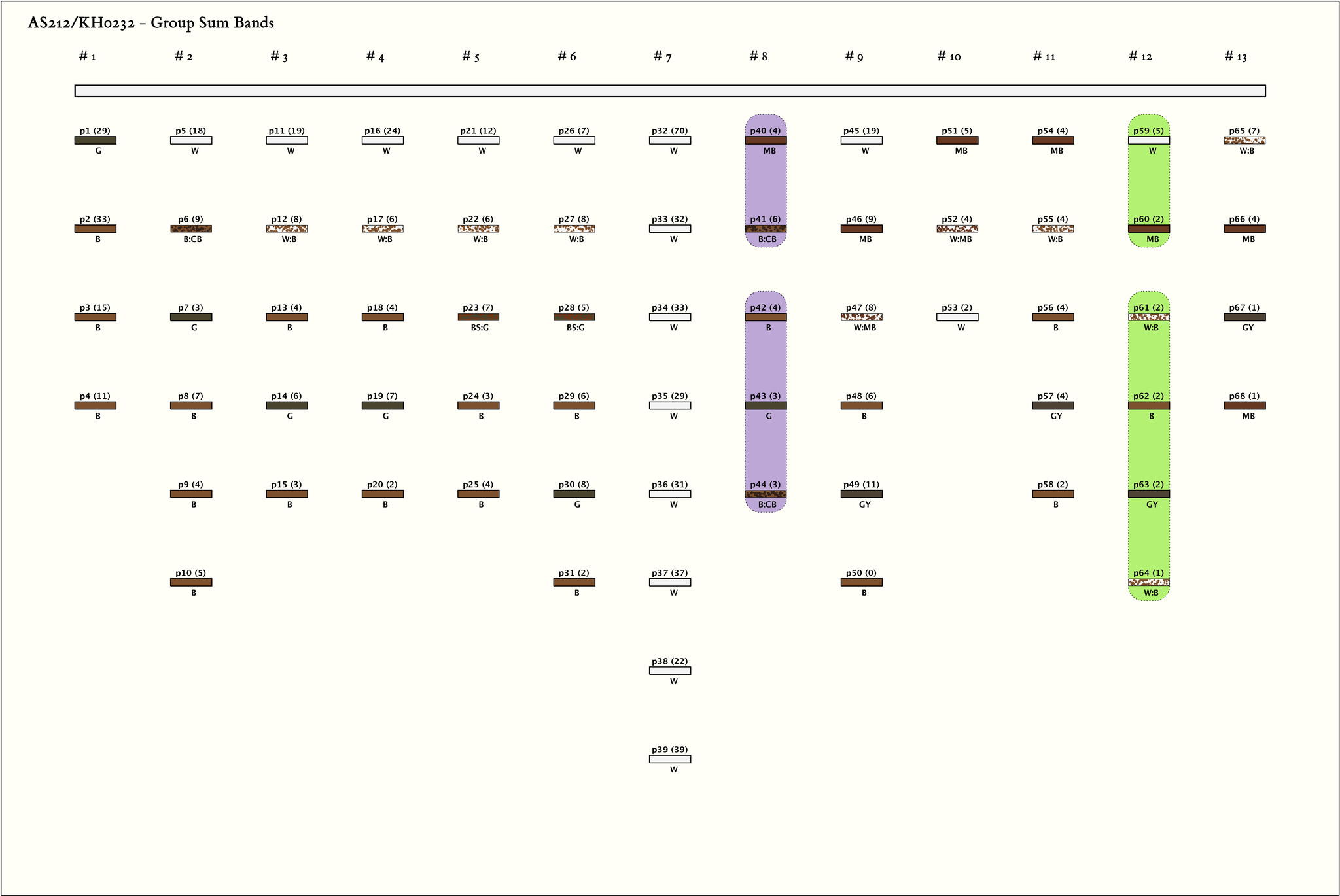AS212/KH0232 - Group Sum Bandss
Drawings:
Group Sum Bands:
Click on Image to View Larger
Individual Group Sum Bands: - Click on column name to sort
| # | Group Sum Bands Schema | Group Position 1 Based Index |
Split Index 1 Based Index |
Left Sum 1 Based Index |
Right Sum 1 Based Index |
|---|---|---|---|---|---|
| 0 |  | 007 | 3 | 10 = MB@[8, 1]:4 + W@[8, 1, 1]:2 | 10 = B:CB@[8, 2]:6 + W@[8, 2, 1]:1 + B@[8, 3]:4 + B@[8, 3, 1]:7 + G@[8, 4]:3 + GY@[8, 4, 1]:2 + B:CB@[8, 5]:3 + W@[8, 5, 1]:2 |
| 1 |  | 011 | 3 | 7 = W@[12, 1]:5 + B@[12, 1, 1]:3 | 7 = MB@[12, 2]:2 + W@[12, 2, 1]:2 + W:B@[12, 3]:2 + B@[12, 4]:2 + B@[12, 4, 1]:1 + GY@[12, 5]:2 + W:B@[12, 6]:1 + W:B@[12, 6, 1]:2 |
Khipu Notes:
By permission of The Joslyn Museum:
 Khipu, Inka, 1400–1570, cotton, length: 25 in (63.5 cm), Joslyn Art Museum, Omaha, Nebraska, Gift of Harold Kaye, 1958.57
Khipu, Inka, 1400–1570, cotton, length: 25 in (63.5 cm), Joslyn Art Museum, Omaha, Nebraska, Gift of Harold Kaye, 1958.57
Ascher Databook Notes:
 Khipu, Inka, 1400–1570, cotton, length: 25 in (63.5 cm), Joslyn Art Museum, Omaha, Nebraska, Gift of Harold Kaye, 1958.57
Khipu, Inka, 1400–1570, cotton, length: 25 in (63.5 cm), Joslyn Art Museum, Omaha, Nebraska, Gift of Harold Kaye, 1958.57
Ascher Databook Notes:
- Construction Note: Two cords of 30 cm. and 19 cm. are knotted together and knotted to the main cord within this space. Both cords appear to have been cut. The cords are undyed (W) but have marks of being unravelled from some mottled combination. The cord attachments do not appear to be part of the original khipu construction and there is nowhere on the khipu they seem to have come from.
- Construction Note: Three cords of color MB are wrapped around the end knot giving the effect of a six strand fringe. The strands of the fringe are 3.0 - 6.0 cm. long. The cords appear to have been cut after being attached.
- Construction Note: The pendant was tied loosely around the main cord in the space between pendants 44 and 45. This is not an original attachment and the top portion of the pendant is clearly broken. A small space o n the main cord between pendants 45 and 47 suggest this as the original place of the pendant. Also, this placement is consistent with the color and subsidiary pattern of Part IV as described in Observation 9. We, therefore, assume this to be the original place of the pendant. Note that the length measurements begin at the broken end of the pendant cord. A piece of about 7.0 cm. is probably missing.
- By color, group sizes, and spaces along the main cord, the khipu resolves into five parts of 2, 4, 1, 5, 1 groups respectively. The groups each contain from 4 to 8 pendant cords. The parts, alone and in comparison, are discussed in the observations that follow.
- Part I is two groups of 4 and 6 pendants respectively. The first group shares the color pattern of the last four pendants in the next group so that Part I can be described as:
P1ij For i=(1,2); j=(1,...,6) (with j≠(1,2) for i=1)
with subsidiaries P1ijs for i=1; j=(1,2)
- Part II is four groups sharing the six color pattern W, B:W, BS:G, B, G, B. In all four groups the first and second pendant positions have subsidiaries of color B. Although the subsidiaries on both pendant positions are the same color, they differ consistently in their placement. Part II can be described as:
P2ij for i=(1,...,4); j=(1,...6) (j≠3 for i=1,2 and j≠5 for i=3)
with subsidiaries P2ijs for all i and j=(1,2)
- Parts I and II: The placement and color of subsidiaries are the same for both parts. Also, the pendant colors are the same in both parts for pendant positions j=(1,4,6)
- Part III is one group of 8 white pendants with no subsidiaries. The color, number of pendants, and values on the pendants distinguish this group from the rest of the khipu. The values on these pendants range from 22 to 70 while only three other values on the entire khipu are larger than 19. (Two of the three are adjacent values in group 1 and are the same as two adjacent values in this group.)
- Part IV is two sets of two groups each. The sets are separated by a large space along the main cord in which is centered a group of three upward facing cords.
- Each set is a group of 5 pendants followed by a group of 6 pendants. All share a somewhat similar color pattern: W (or not present), MB, (varies), B, G or GY, (varies) with a B subsidiary and W subsidiary on the first and second pendants respectively and one, two, or no subsidiaries of varying colors on the other positions. The two sets can be summarized as:
P4ij i=(1,...,4); j=(2,...,6) fori=1,3; and j=(1,...,6) for i=(2,4)
with subsidiaries P4ijk where k=1 for j=(1,2); k=(0,1,2) for j=3; and k=(0,1) for j=(4,5,6)
- There are two arithmetic regularities:
- For i=(2,4) P4i1 = 2 P4i2 +1 (or[P412/2]=P4i1);
- For j=(2,...,6) P43j = 2 P44j
- Each set is a group of 5 pendants followed by a group of 6 pendants. All share a somewhat similar color pattern: W (or not present), MB, (varies), B, G or GY, (varies) with a B subsidiary and W subsidiary on the first and second pendants respectively and one, two, or no subsidiaries of varying colors on the other positions. The two sets can be summarized as:
- Parts I, II, and IV: These all share a W pendant with a B subsidiary for j=1, a subsidiary for j=2, and a B colored pendant for j=4. The pendant values (with the exception of the first group in Part I) range from 1 to 1 1 for j =2,..., 6 while those for j =l range from 5 t o 24. All subsidiary values are between 0 and 7.
- Part V is a single group of 4 pendants separated from the rest of the groups by a large space along the main cord. Some similarity of color and pendant values suggests that these be associated with j=(3,...,6)
